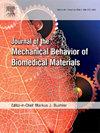Asymmetric sample shapes complicate planar biaxial testing assumptions by intensifying shear strains and stresses
IF 3.3
2区 医学
Q2 ENGINEERING, BIOMEDICAL
Journal of the Mechanical Behavior of Biomedical Materials
Pub Date : 2024-11-05
DOI:10.1016/j.jmbbm.2024.106795
引用次数: 0
Abstract
Planar biaxial testing offers a physiologically relevant approach for mechanically characterizing thin deformable soft tissues, but often relies on erroneous assumptions of uniform strain fields and negligible shear strains and forces. In addition to the complex mechanical behavior exhibited by soft tissues, constraints on sample size, geometry, and aspect ratio often restrict sample shape and symmetry. Using simple PDMS gels, we explored the unknown and unquantified effects of sample shape asymmetry on planar biaxial testing results, including shear strain magnitudes, shear forces measured at the sample’s boundary, and the homogeneity of strains experienced at the center of each sample. We used a combination of finite element modeling and experimental validation to examine PDMS gels of varying levels of asymmetry, allowing us to identify effects of sample shape without confounding factors introduced by the nonlinear, spatially variable, and anisotropic properties of soft tissues. Both biaxial simulations and experiments, which showed strong agreement, revealed that sample shape asymmetry led to significantly larger shear strains, shear forces, and overestimation of principal stresses. Excluding these shear forces resulted in an underestimation of shear moduli during inverse mechanical characterizations. Even in the simplest of deformable biomaterials, sample shape asymmetry should be avoided as it can induce drastic increases in shear strains and shear forces, invalidating traditional planar biaxial testing analyses. Alternatively, sample shape asymmetry may be exploited to generate more robust estimates of constitutive parameters in more complex materials, which could lead to a refined understanding and inference of mechanical behavior.
样品形状不对称会加剧剪切应变和应力,从而使平面双轴测试假设变得复杂。
平面双轴测试提供了一种与生理相关的方法,用于对薄的可变形软组织进行机械表征,但往往依赖于错误的假设,即均匀应变场和可忽略的剪切应变和剪切力。除了软组织表现出的复杂机械行为外,样品尺寸、几何形状和长宽比等方面的限制往往也会限制样品的形状和对称性。利用简单的 PDMS 凝胶,我们探索了样品形状不对称对平面双轴测试结果的未知和未量化影响,包括剪切应变幅度、样品边界测得的剪切力以及每个样品中心的应变均匀性。我们采用有限元建模和实验验证相结合的方法,对不同不对称程度的 PDMS 凝胶进行了研究,从而确定了样品形状的影响,避免了软组织的非线性、空间可变性和各向异性带来的干扰因素。双轴模拟和实验结果表明,样本形状不对称会导致剪切应变和剪切力显著增大,并高估主应力,这两者显示出很强的一致性。如果不考虑这些剪切力,就会在反机械特性分析过程中低估剪切模量。即使是最简单的可变形生物材料,也应避免样品形状不对称,因为它会导致剪切应变和剪切力急剧增加,使传统的平面双轴测试分析失效。另外,也可以利用样品形状的不对称来对更复杂材料的构成参数进行更可靠的估计,从而加深对机械行为的理解和推断。
本文章由计算机程序翻译,如有差异,请以英文原文为准。
求助全文
约1分钟内获得全文
求助全文
来源期刊

Journal of the Mechanical Behavior of Biomedical Materials
工程技术-材料科学:生物材料
CiteScore
7.20
自引率
7.70%
发文量
505
审稿时长
46 days
期刊介绍:
The Journal of the Mechanical Behavior of Biomedical Materials is concerned with the mechanical deformation, damage and failure under applied forces, of biological material (at the tissue, cellular and molecular levels) and of biomaterials, i.e. those materials which are designed to mimic or replace biological materials.
The primary focus of the journal is the synthesis of materials science, biology, and medical and dental science. Reports of fundamental scientific investigations are welcome, as are articles concerned with the practical application of materials in medical devices. Both experimental and theoretical work is of interest; theoretical papers will normally include comparison of predictions with experimental data, though we recognize that this may not always be appropriate. The journal also publishes technical notes concerned with emerging experimental or theoretical techniques, letters to the editor and, by invitation, review articles and papers describing existing techniques for the benefit of an interdisciplinary readership.
 求助内容:
求助内容: 应助结果提醒方式:
应助结果提醒方式:


